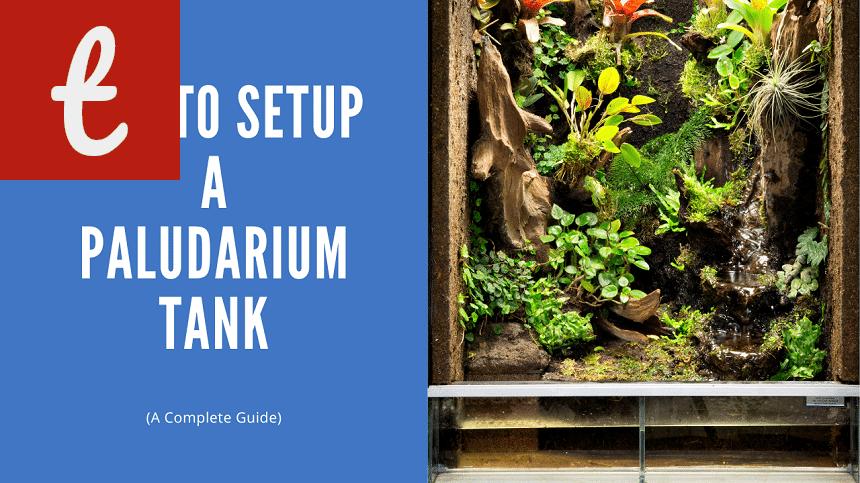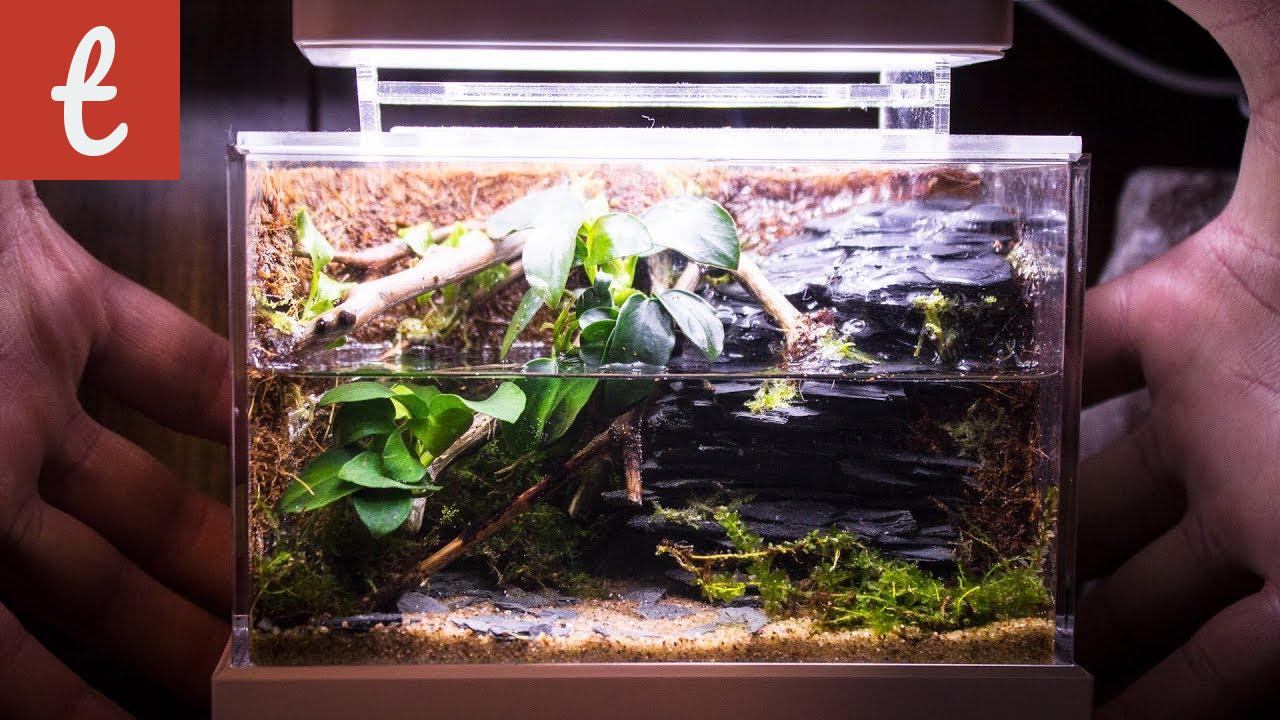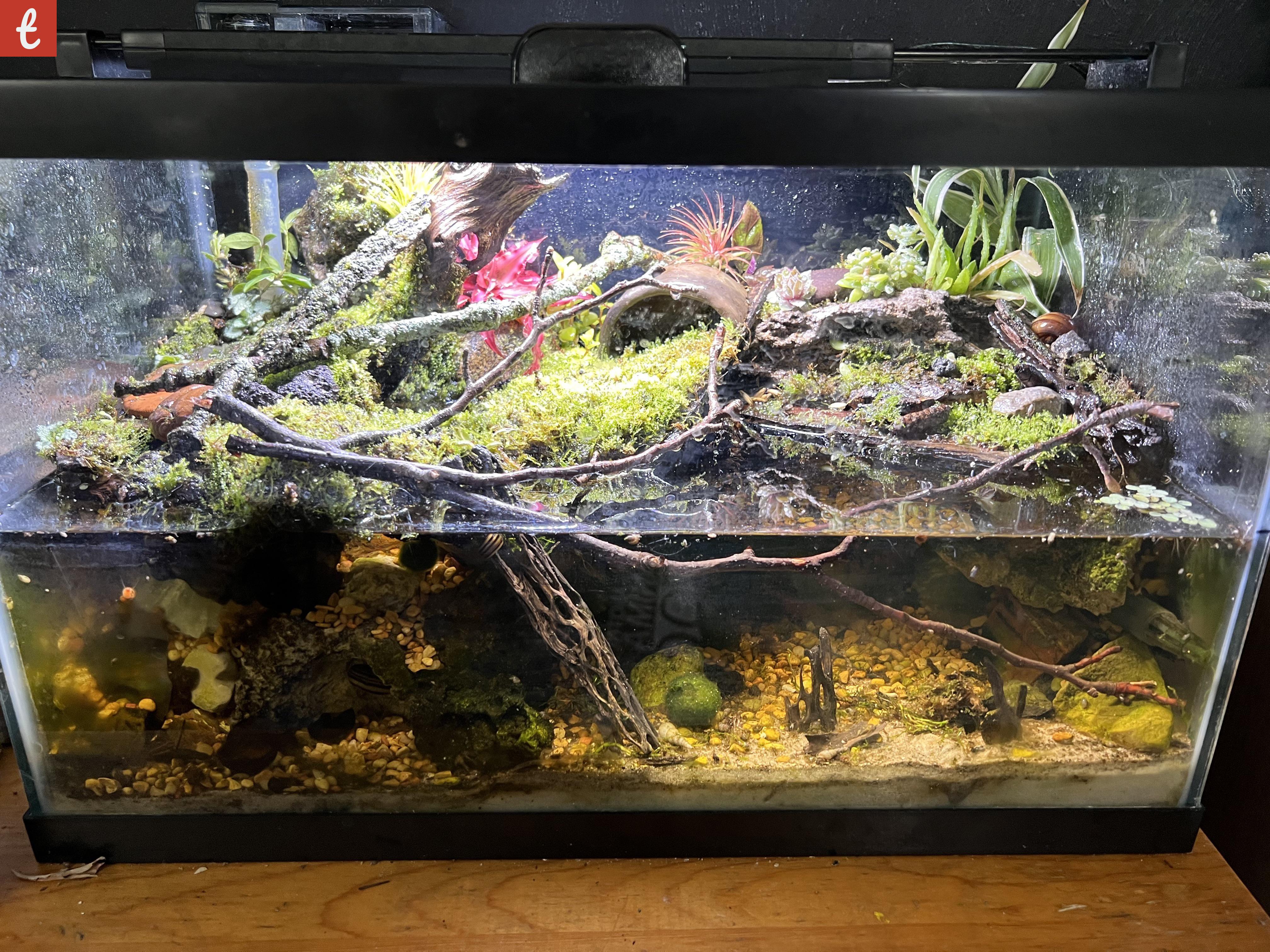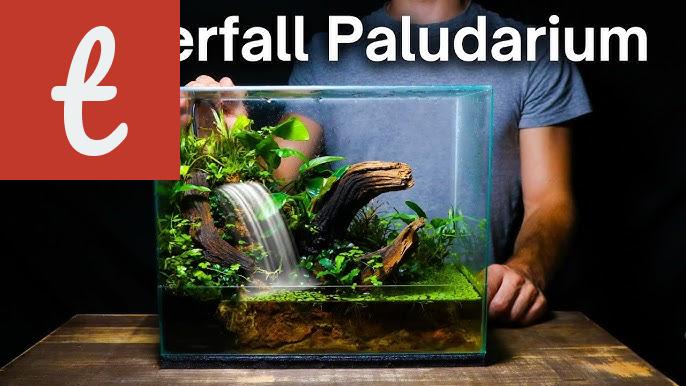The Ultimate Guide to Creating a Compact Paludarium
Are you a nature enthusiast looking to bring the beauty of the outdoors into your living space? Look no further than a compact paludarium! A paludarium is a unique and captivating way to display a little slice of nature in your home or office. In this ultimate guide, we will walk you through the process of creating your very own compact paludarium, a mini-ecosystem that combines aquatic and terrestrial elements.
What is a Paludarium?
A paludarium is a carefully designed and controlled environment that houses a variety of plants, animals, and aquatic life. It typically includes both a water section for aquatic creatures and a dry section for terrestrial plants and animals. This fascinating combination allows for the observation of a diverse range of species and the replication of natural ecosystems.
Choosing the Right Container
The first step in creating a compact paludarium is selecting the right container. You can choose from various options such as glass tanks, fish tanks, or even repurposed containers like terrariums or aquariums. Consider the size of the container and the space available in your home or office. Ensure it has a secure lid to maintain proper humidity levels and prevent any escapees.
Creating the Aquatic Environment
Start by adding a layer of aquatic soil substrate to the bottom of your container. This will provide essential nutrients for your aquatic plants. Next, carefully add filtered water, ensuring that it is free from chemicals like chlorine. Install a small water pump and a water filter to keep the water clean and circulating.
Now comes the fun part – adding aquatic plants and animals. Choose plants and fish that are suitable for a compact paludarium environment. Some popular choices include Anubias, Java Fern, Killifish, and Guppies. Remember to research the specific needs of each species and provide appropriate lighting and temperature conditions.
- Pro tip: Adding live aquatic plants not only enhances the visual appeal but also helps to maintain water quality by absorbing nutrients and producing oxygen.
- Pro tip: Consider adding driftwood, rocks, and other natural decor to create a realistic and visually pleasing underwater landscape.
Building the Terrestrial Habitat
In the dry section of your compact paludarium, you can create a mini jungle or a desert oasis, depending on your preference. Start by adding a layer of substrate that suits the plants you wish to grow. For tropical plants, choose a well-draining potting soil mix, while desert plants thrive in sandy or rocky substrates.
Select plants that are well-suited for terrariums or vivariums, such as mosses, ferns, bromeliads, or succulents. Arrange them creatively, considering their growth habits and aesthetics. It's also important to provide adequate lighting, ventilation, and temperature control to mimic the natural environment.
Maintaining Your Compact Paludarium
Proper maintenance is key to the longevity and health of your paludarium. Monitor the water temperature, pH levels, and lighting regularly. Trim and prune plants as needed to prevent overcrowding and maintain a balanced ecosystem.
Conclusion
Creating a compact paludarium is an exciting and rewarding project for nature lovers. With the right container, proper substrate, suitable plants, and animals, you can enjoy the beauty of both aquatic and terrestrial ecosystems in one stunning display. Remember to provide ongoing care and monitor the health of your living creatures. Now, go ahead and embark on your journey to create your very own compact paludarium!
Building a Tiny Paludarium: A Step-by-Step Guide
A paludarium is a unique and captivating way to bring a small slice of nature into your home. It combines elements of both a terrestrial and aquatic environment, creating a beautiful and dynamic habitat that can be enjoyed by both plants and animals.
Whether you're a seasoned aquarium enthusiast or simply looking for a new project to tackle, building a tiny paludarium can be a rewarding and satisfying experience. In this step-by-step guide, we will walk you through the process of creating your own miniature aquatic wonderland.
- Step 1: Planning
Before you begin, it's crucial to plan out your paludarium carefully. Determine the size you want and consider the space and resources available to you. Think about the types of plants and animals you'd like to include and research their specific requirements. Additionally, consider the lighting, filtration, and heating necessary for maintaining a healthy environment.
- Step 2: Selecting the Container
The next step is to choose a container that will serve as the foundation for your paludarium. Opt for a glass enclosure as it allows for easy viewing and monitoring of the ecosystem. Consider the size, shape, and lid options, ensuring it provides adequate ventilation.
- Step 3: Creating the Land Area
In a paludarium, the land area is where your plants and terrestrial animals will reside. Begin by creating a substrate layer using a mix of soil, sand, and rocks. This will ensure proper drainage and support plant growth. Create hills and valleys in the substrate to achieve a natural-looking landscape.
Now it's time to add plants. Choose species that thrive in both aquatic and terrestrial conditions. Mosses, ferns, and bromeliads are popular choices. Place taller plants at the back and shorter ones towards the front, creating depth and visual interest.
- Step 4: Setting Up the Water Area
The water area is the heart of the paludarium and where your aquatic plants and animals will flourish. Start by placing a layer of pumice or gravel at the bottom to aid in water circulation and filtration. Then, carefully pour dechlorinated water into the container, leaving enough space for your aquatic plants and any fish or invertebrates you plan to add.
Include decorative elements such as rocks, driftwood, or aquatic ornaments to enhance the visual appeal. Plant aquatic plants such as Anubias, Java fern, or Amazon swords to provide shelter and cover for your aquatic inhabitants.
- Step 5: Maintaining and Monitoring
Now that your paludarium is set up, it's essential to maintain and monitor the ecosystem regularly. Test the water parameters regularly to ensure they are within the appropriate range for your plants and animals. Monitor the temperature, humidity levels, and lighting conditions to ensure they remain optimal.
Perform routine water changes, trimming of plants, and removal of any decaying matter to keep the paludarium clean and healthy. Regularly inspect the equipment for any signs of malfunction or wear and tear.
Building a tiny paludarium offers a creative outlet while providing a unique and captivating living space for plants and animals. With careful planning and diligent maintenance, your tiny paludarium can become a stunning centerpiece in your home.
The Art of Designing a Miniature Paludarium
Creating a miniature paludarium is not only a hobby but also an art form. It combines the beauty of aquatic and terrestrial elements, resulting in a mesmerizing and vibrant living display. Whether you are new to paludariums or an experienced aquarist, designing your own mini masterpiece can be a rewarding and creative process.
One of the first steps in designing a miniature paludarium is choosing the right container or tank. The size and shape of the container will greatly influence the final outcome. Popular choices include glass aquariums, glass terrariums, or even custom-built enclosures. Consider the space you have available and the specific needs of the plants and animals you wish to keep.
- Choose your plant life carefully. When it comes to selecting plants for your paludarium, aim for a balance between aquatic and terrestrial species. Popular choices include ferns, mosses, and bromeliads. Ensure that the plants you choose are compatible with the water conditions and lighting in your paludarium. Creating different levels of vegetation can add depth and interest to your design.
- Introduce aquatic life. Adding aquatic creatures such as fish, shrimp, or snails can bring your miniature ecosystem to life. Research the specific requirements of the animals you choose to ensure they can thrive in the conditions of your paludarium. Consider the size of the tank and the compatibility of the different species you wish to keep.
Once you have selected your plants and animals, it's time to bring your paludarium to life. Start by creating a stable foundation with a layer of substrate. Use a mixture of soil, sand, and gravel to provide a suitable growing medium for your plants. Consider adding a layer of activated carbon to help maintain water quality.
Next, add water to your paludarium. Use dechlorinated water, preferably at room temperature, to avoid shocking the plants and animals. The water level should be suitable for both the aquatic and terrestrial components of your design. Consider adding a small pump or filter to maintain water circulation and prevent stagnation. However, ensure that the flow is gentle enough to not disturb your plants or overwhelm your animals.
Lighting is a crucial element in the success of your miniature paludarium. Different plants have varying light requirements, so choose an appropriate lighting system that can provide suitable intensity and spectrum. LED lights are commonly used in paludariums due to their energy efficiency and versatility.
Decorate your paludarium with carefully chosen rocks, branches, and other decorative elements to create a natural and visually appealing environment. These can provide hiding spots and climbing surfaces for your animals, as well as anchor points for epiphytic plants.
Maintaining a healthy paludarium requires regular care. Monitor water parameters such as temperature, pH, and ammonia levels to ensure they remain within the optimal range for your inhabitants. Prune your plants regularly to prevent overcrowding and maintain a tidy appearance. Perform routine water changes to keep the water clean and clear.
Designing a miniature paludarium is an art that allows you to create a captivating and self-sustaining ecosystem. With careful planning, research, and attention to detail, you can design a miniature world that will bring you joy and fascination for years to come.

How to Build a Small Paludarium: Beginner's Edition
Are you interested in creating a unique and captivating habitat in your home or office? A paludarium could be the perfect solution! Combining elements of both an aquarium and a terrarium, a paludarium is a self-contained ecosystem that allows you to showcase both aquatic and terrestrial plants and animals. In this article, we will walk you through the basics of building a small paludarium, perfect for beginners.
Before you begin, it's essential to gather all the necessary materials. You will need a glass or acrylic tank, substrate for the terrestrial area, aquatic plants, moss, rocks, driftwood, a water pump, a heater (if desired), a light source, and a misting system. Once you have everything ready, follow these steps:
- Step 1: Planning and Design
- Step 2: Setting the Foundation
- Step 3: Adding Water
- Step 4: Plant and Décor Placement
- Step 5: Installing Equipment
Start by sketching out your paludarium design. Consider the size of your tank, the placement of rocks and driftwood, and the type of plants and animals you want to include. It's crucial to create a natural-looking environment that suits the needs of the inhabitants.
Add a layer of substrate to the terrestrial area of your tank. This can be a mix of soil, sand, and coconut fiber, creating a suitable environment for plant growth. Ensure to provide different levels and slopes to create depth and interest in your paludarium.
Fill the aquatic area of your tank with dechlorinated water. The depth of the water should vary to accommodate different aquatic plants and animals. It's important to maintain the right water parameters for the specific creatures you plan to keep. A water pump can help with circulation and oxygenation.
Now it's time to add plants, moss, rocks, and driftwood. Consider placing taller plants in the terrestrial area and shorter ones in the aquatic area. Use rocks and driftwood to create hiding spots and platforms. Moss can be added to create a lush and natural look.
Install a suitable light source above your paludarium to provide the necessary spectrum for plant growth. A misting system can help maintain humidity levels, especially if you have tropical plants or amphibians. If needed, install a heater to keep the water temperature stable.
With these basic steps, you are well on your way to building your very own small paludarium. Remember to conduct thorough research on specific plant and animal species to ensure their compatibility and well-being. Regular maintenance, such as pruning plants and monitoring water parameters, is crucial to keep your paludarium thriving.
Building and maintaining a paludarium can be a rewarding and educational experience. It offers a glimpse into the fascinating world of both aquatic and terrestrial ecosystems within a confined space. Start small, learn as you go, and soon you'll be an expert in creating captivating miniature ecosystems.
Creating a Nano Paludarium: Tips and Tricks
Are you a nature lover who wants to bring the beauty of aquatic plants and small animals into your living space? A nano paludarium might be the perfect solution for you. A nano paludarium is a miniaturized version of a paludarium, which is a setup that combines aquatic and terrestrial elements in a single habitat. In this article, we will discuss some tips and tricks to create an enchanting nano paludarium that will captivate your senses.
First and foremost, it is important to choose the right container for your nano paludarium. Popular options include glass aquariums or terrariums, as they provide excellent visibility and are easy to maintain. Opt for a container with a capacity of 5-10 gallons, as this size is ideal for miniaturized setups.
- Consider the fauna and flora that you want to include in your nano paludarium. Research the specific requirements and compatibility of the organisms you wish to keep. Some popular choices for aquatic plants include Java moss, Anubias, and Amazon swords. As for animals, you may consider dwarf shrimp, small fish species like Rasboras or Tetras, or amphibians like dart frogs.
- Create a natural-looking habitat by using a combination of rocks, driftwood, and live plants. These elements not only enhance the aesthetic appeal but also provide hiding spots and perches for your animals. Arrange them in a way that mimics a natural environment, with different levels of water and land.
When setting up the land area of your nano paludarium, it is essential to create a proper drainage system to avoid waterlogging. Use a layer of aquarium-safe substrate, such as coconut fiber or soil, and add a layer of gravel or pebbles on top. This will allow excess water to drain, preventing root rot and maintaining the ideal moisture level.
Lighting is a vital aspect to consider when creating a nano paludarium. Most aquatic plants require moderate to high-intensity lighting to thrive. LED lights are a popular choice among hobbyists, as they provide excellent illumination while being energy-efficient. Place the lights strategically to ensure proper coverage for both the aquatic and terrestrial sections of your paludarium.
Regular maintenance is crucial to keep your nano paludarium flourishing. Monitor the temperature, humidity, and water parameters regularly to ensure they stay within the required range for your chosen flora and fauna. Perform water changes as necessary and trim any overgrown plants to maintain a healthy balance.
In conclusion, creating a nano paludarium allows you to bring the beauty of aquatic and terrestrial ecosystems into your home on a small scale. By choosing the right container, selecting compatible fauna and flora, creating a natural habitat, providing appropriate lighting, and ensuring regular maintenance, you can create a captivating nano paludarium that will be a source of tranquility and wonder.




Comments on "A Guide To Building The Smallest Paludarium"
No comment found!